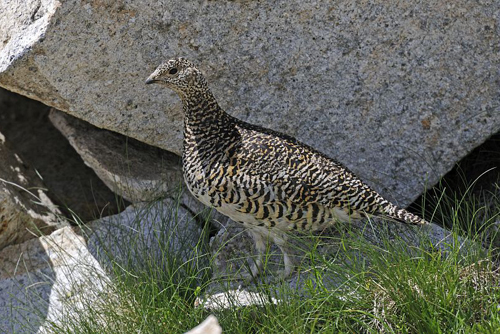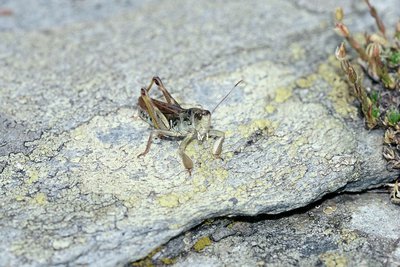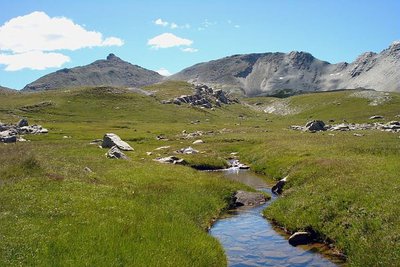
The Estrop Valley
6 points of interest

Bouquetin des Alpes, (Capra Ibex). Groupe de bouquetins. - Philippe PIERINI  Fauna
FaunaAlpine ibex (Capra ibex)
A symbol of the high mountains and their giddying peaks, this ungulate disappeared from this region more than 150 years ago.
Since 1987, reintroduction operations have been jointly undertaken by the Mercantour National Park and the Parco naturale Alpi Marittime.
A group of fifty or so have settled at Roche Grande.
To allow them to be identified, the animals are given coloured ear tags. The park staff regularly monitor the development of the species.
Gomphocère des alpages ou criquet de Sibérie, sur un rocher, (Gomphocerus sibiricus). - MALAFOSSE Jean-Pierre  Fauna
FaunaSiberian cricket (Aeropus sibericus)
During the great glacial periods, this orthoptera lived on the plains. As the climate has warmed back up, it has moved to the high mountains, above 2000m. The male can be recognised thanks to the its bulging back legs, hence its surname of “Popeye”. This herbivore, whose predators include birds, marmots and foxes, is part of the food chain in high-altitude pastures.
Zone humide dans le vallon de l'Estrop. - COSSA Jean-Louis  Pastoralism
PastoralismPastoralism
This grassy valley called Estrop (stropia: flock) a been used for pastoral purposes for many a long year: 1500 sheep graze it from August to September. The hut serves as a shelter for the shepherd. The flock rests on the knoll as the abundance of nettles and wild spinach attest. The Alpine grass is a fragile environment where the National Park helps ensure that a biological balance is maintained, while trying to improve the working conditions of shepherds.
Blockhaus sous le col de Gialorgues dans le vallon de l'Estrop à Entraunes. - Marion BENSA  History and historical trail
History and historical trailMilitary remains
Just before the Second World War, the French army decided to build fortifications (bunkers) on Col de Gialorgues with a few to stopping a possible Italian invasion. Military authorities aimed to open a sufficiently wide track to allow all-terrain vehicles to reach Col de Gialorgues. Materials were transported by mules from the camp which was set up at the foot of the Estenc woods, but the soldiers had to rapidly give up due to the stony nature of the ground.
Le lac de l'Estrop un jour d'été, commune d'Entraunes. - Marion BENSA  Lake
LakeThe Estrop lakes
Around 10000 years ago, the glacier occupied the whole valley before it gradually shrank as the climate warmed up, leaving a body of water behind each glacial rock bar. Slowly, erosion overcame this stock of water. Ad you head up the valley, you are also heading back in time: grasses towards the bottom, peat bogs in the middle, lakes towards the top. Around the wetland areas, Arcto-Alpine species flourish such as the cane and Zweifarbige Seggen which are protected at both a national and a European level.
Lagopède alpin, (Lagopus mutus). En été, une femelle lagopède dans les rochers avec ses quatre poussins. - Jacques BLANC  Fauna
FaunaWhite-tailed ptarmigan (Lagopus mutus)
Also known as the snow quail (or “jalabre” in the local dialect), this bird of the Tetraoninae family is a familiar sight in the high mountains. It is perfectly adapted to the cold and lives all year round at 2500 - 3000m. Three to four times per year, it changes its feathers according to its surrounding environment. In the autumn, the ptarmigans can join together in groups of 20 to 25 individuals. Their main predators are stoats and golden eagles.
Description
From the entrance to the National Park, follow the itinerary signposted "Col de Gialorgues". Cross the Sanguinière valley and follow the canal until marker 282.
A gentle descent through a larch forest leads to the bottom of the Estrop valley, marker 283.
After going over a huge scree, head left at the first intersection.
A zigzagging climb leads to a flatter grassy section populated by Siberian grasshoppers. On the right, the peak of Roche Grande (2752m) where the Alpine ibex can be observed.
The path then climbs to the location named “L'Entonnoir”, a spectacular place for erosion. Follow the path which snakes away on the left of a waterfall; there, huddled at the base of a rocky ridge, a hut recalls the pastoral use of this area.
The slope is much less pronounced now, making way for a succession of rounded rises and falls. A delightful path bordered by peat bogs leads to a knoll, whence military fortifications can be seen.
You will finally reach the highpoint of the hike in terms of altitude: the Col de Gialorgues. On the right, the Rocher du Pigeon is home to rock ptarmigans.
A variation on the right allows you to explore two small mountain lakes hidden behind a grassy knoll.
Follow the same route on the return journey.
- Departure : Hamlet of Estenc, Entraunes
- Arrival : Hamlet of Estenc, Entraunes
- Towns crossed : Entraunes
Altimetric profile
Recommandations
Access and parking
Report a problem or an error
If you have found an error on this page or if you have noticed any problems during your hike, please report them to us here:
